Leadership Styles and Theories in Aviation Industry: A Case Study of British Airways
VerifiedAdded on 2023/06/09
|13
|3811
|225
AI Summary
This report discusses the different styles of leadership and compares two academic theories and models. It also explores how such theories are applied to the post pandemic situations and what changes were brought in the leadership and management of British Airways.
Contribute Materials
Your contribution can guide someone’s learning journey. Share your
documents today.
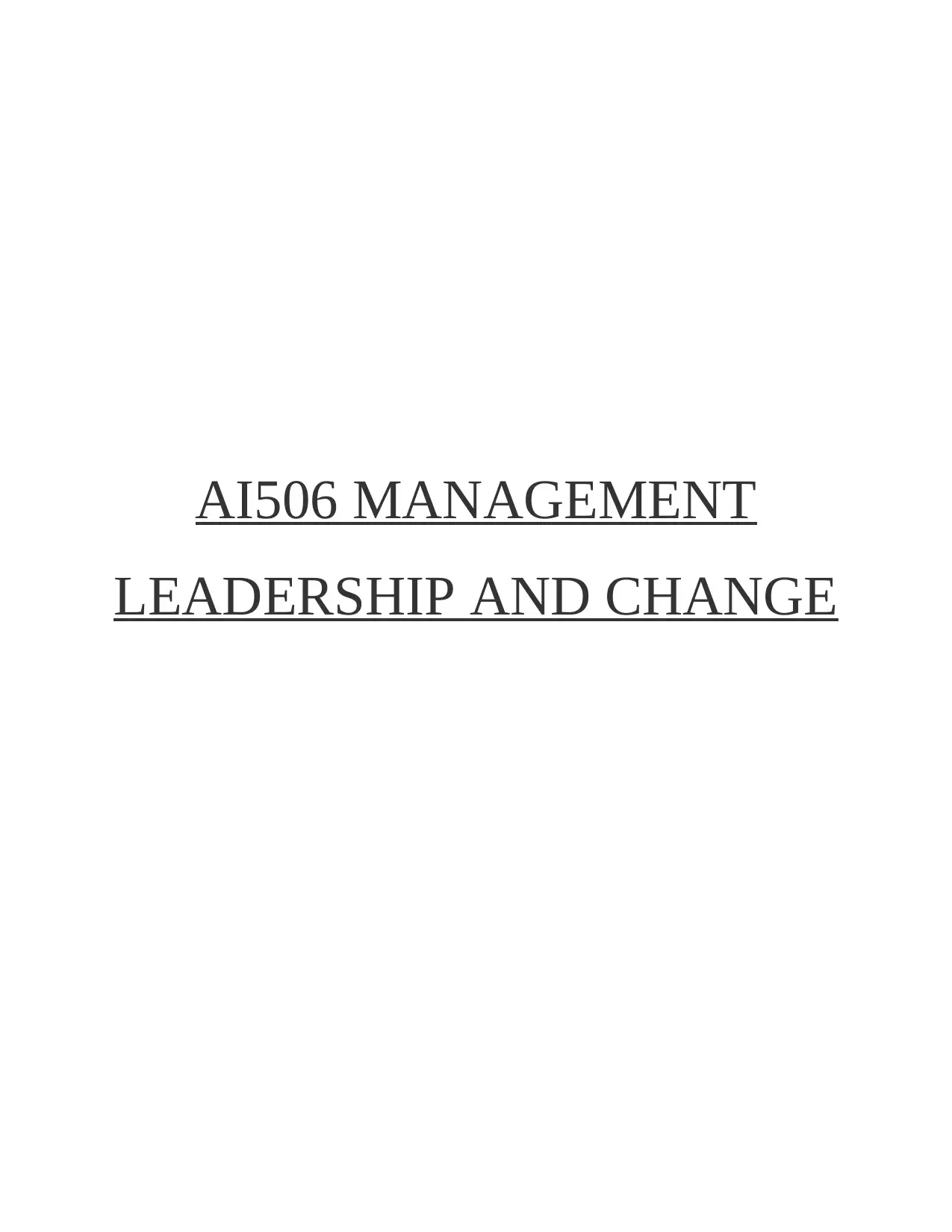
AI506 MANAGEMENT
LEADERSHIP AND CHANGE
LEADERSHIP AND CHANGE
Secure Best Marks with AI Grader
Need help grading? Try our AI Grader for instant feedback on your assignments.
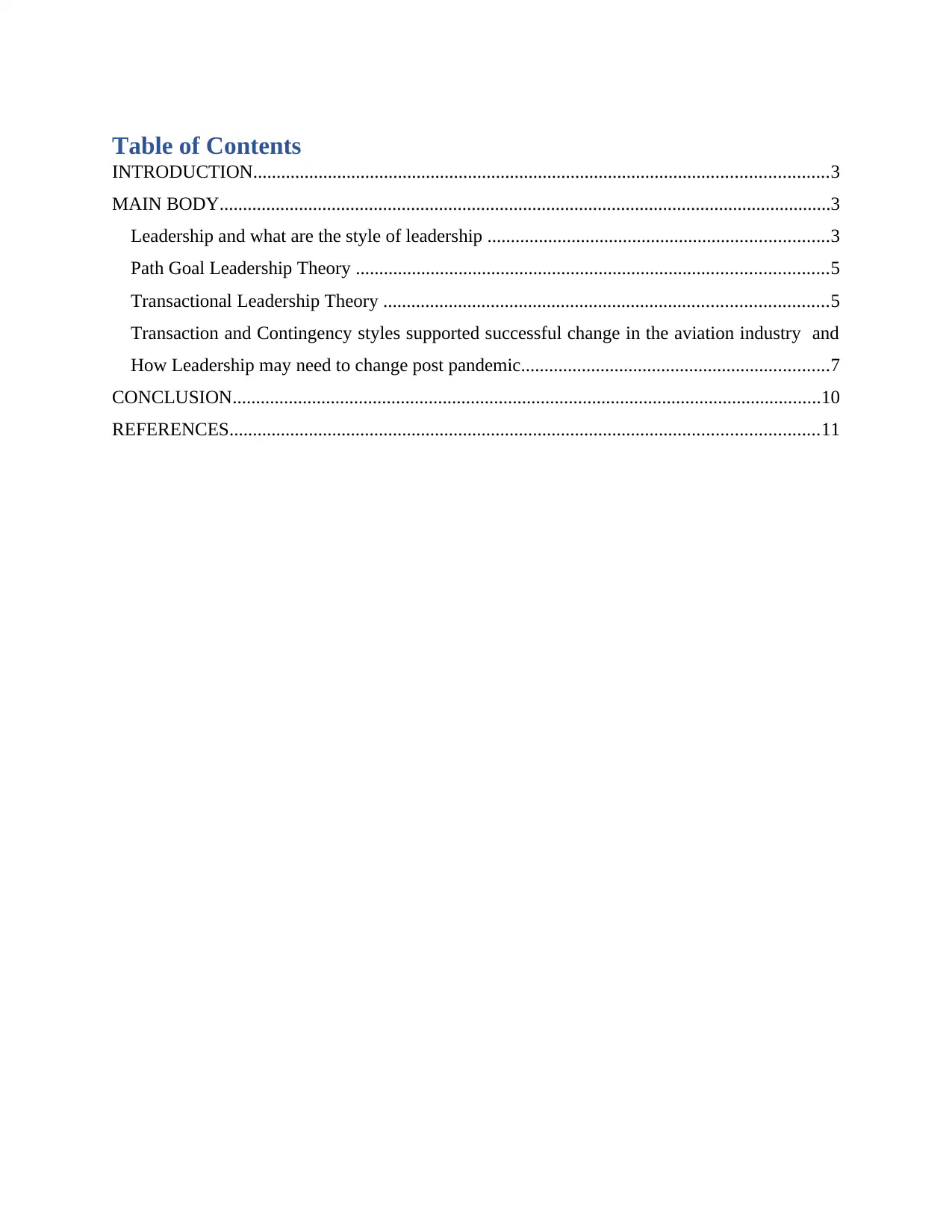
Table of Contents
INTRODUCTION...........................................................................................................................3
MAIN BODY...................................................................................................................................3
Leadership and what are the style of leadership .........................................................................3
Path Goal Leadership Theory .....................................................................................................5
Transactional Leadership Theory ...............................................................................................5
Transaction and Contingency styles supported successful change in the aviation industry and
How Leadership may need to change post pandemic..................................................................7
CONCLUSION..............................................................................................................................10
REFERENCES..............................................................................................................................11
INTRODUCTION...........................................................................................................................3
MAIN BODY...................................................................................................................................3
Leadership and what are the style of leadership .........................................................................3
Path Goal Leadership Theory .....................................................................................................5
Transactional Leadership Theory ...............................................................................................5
Transaction and Contingency styles supported successful change in the aviation industry and
How Leadership may need to change post pandemic..................................................................7
CONCLUSION..............................................................................................................................10
REFERENCES..............................................................................................................................11
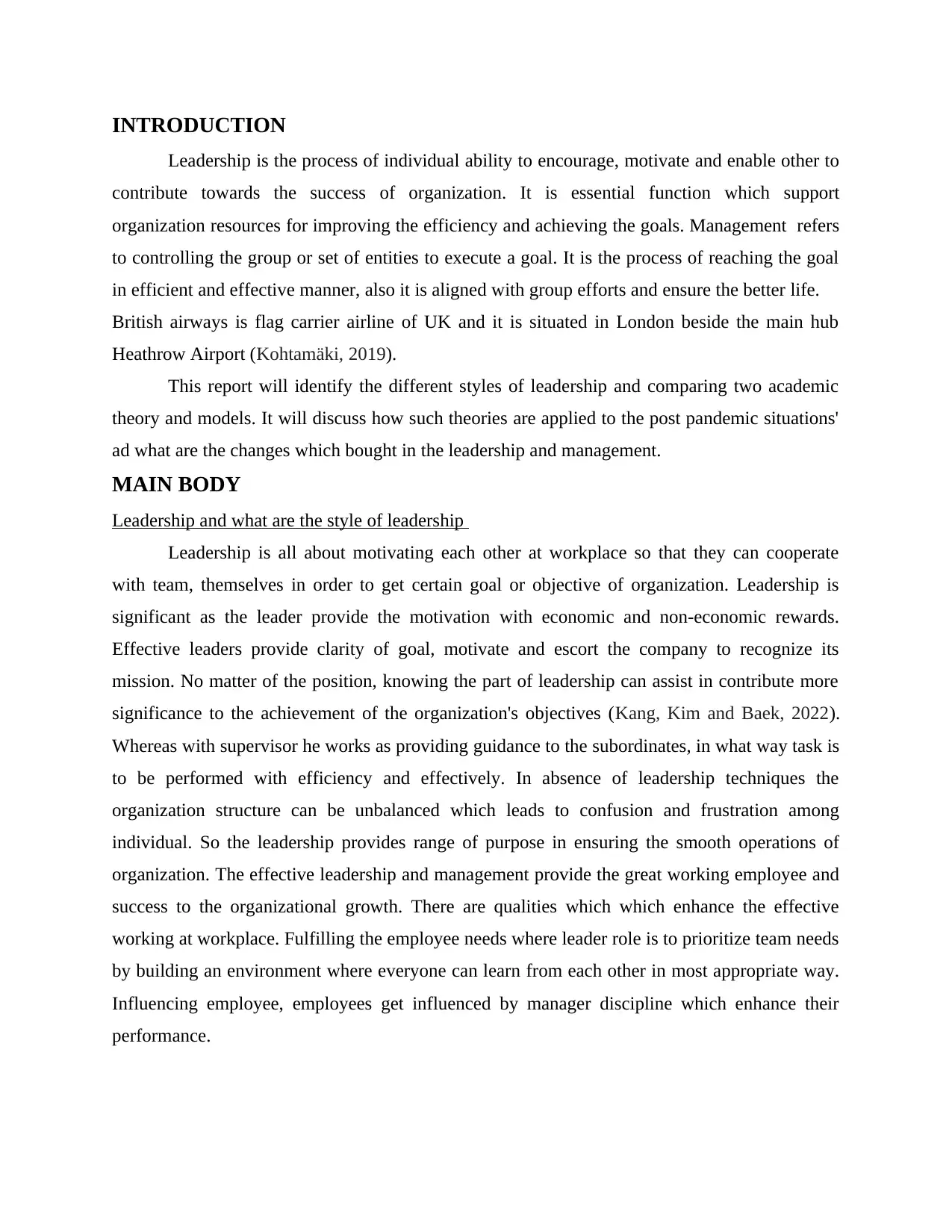
INTRODUCTION
Leadership is the process of individual ability to encourage, motivate and enable other to
contribute towards the success of organization. It is essential function which support
organization resources for improving the efficiency and achieving the goals. Management refers
to controlling the group or set of entities to execute a goal. It is the process of reaching the goal
in efficient and effective manner, also it is aligned with group efforts and ensure the better life.
British airways is flag carrier airline of UK and it is situated in London beside the main hub
Heathrow Airport (Kohtamäki, 2019).
This report will identify the different styles of leadership and comparing two academic
theory and models. It will discuss how such theories are applied to the post pandemic situations'
ad what are the changes which bought in the leadership and management.
MAIN BODY
Leadership and what are the style of leadership
Leadership is all about motivating each other at workplace so that they can cooperate
with team, themselves in order to get certain goal or objective of organization. Leadership is
significant as the leader provide the motivation with economic and non-economic rewards.
Effective leaders provide clarity of goal, motivate and escort the company to recognize its
mission. No matter of the position, knowing the part of leadership can assist in contribute more
significance to the achievement of the organization's objectives (Kang, Kim and Baek, 2022).
Whereas with supervisor he works as providing guidance to the subordinates, in what way task is
to be performed with efficiency and effectively. In absence of leadership techniques the
organization structure can be unbalanced which leads to confusion and frustration among
individual. So the leadership provides range of purpose in ensuring the smooth operations of
organization. The effective leadership and management provide the great working employee and
success to the organizational growth. There are qualities which which enhance the effective
working at workplace. Fulfilling the employee needs where leader role is to prioritize team needs
by building an environment where everyone can learn from each other in most appropriate way.
Influencing employee, employees get influenced by manager discipline which enhance their
performance.
Leadership is the process of individual ability to encourage, motivate and enable other to
contribute towards the success of organization. It is essential function which support
organization resources for improving the efficiency and achieving the goals. Management refers
to controlling the group or set of entities to execute a goal. It is the process of reaching the goal
in efficient and effective manner, also it is aligned with group efforts and ensure the better life.
British airways is flag carrier airline of UK and it is situated in London beside the main hub
Heathrow Airport (Kohtamäki, 2019).
This report will identify the different styles of leadership and comparing two academic
theory and models. It will discuss how such theories are applied to the post pandemic situations'
ad what are the changes which bought in the leadership and management.
MAIN BODY
Leadership and what are the style of leadership
Leadership is all about motivating each other at workplace so that they can cooperate
with team, themselves in order to get certain goal or objective of organization. Leadership is
significant as the leader provide the motivation with economic and non-economic rewards.
Effective leaders provide clarity of goal, motivate and escort the company to recognize its
mission. No matter of the position, knowing the part of leadership can assist in contribute more
significance to the achievement of the organization's objectives (Kang, Kim and Baek, 2022).
Whereas with supervisor he works as providing guidance to the subordinates, in what way task is
to be performed with efficiency and effectively. In absence of leadership techniques the
organization structure can be unbalanced which leads to confusion and frustration among
individual. So the leadership provides range of purpose in ensuring the smooth operations of
organization. The effective leadership and management provide the great working employee and
success to the organizational growth. There are qualities which which enhance the effective
working at workplace. Fulfilling the employee needs where leader role is to prioritize team needs
by building an environment where everyone can learn from each other in most appropriate way.
Influencing employee, employees get influenced by manager discipline which enhance their
performance.
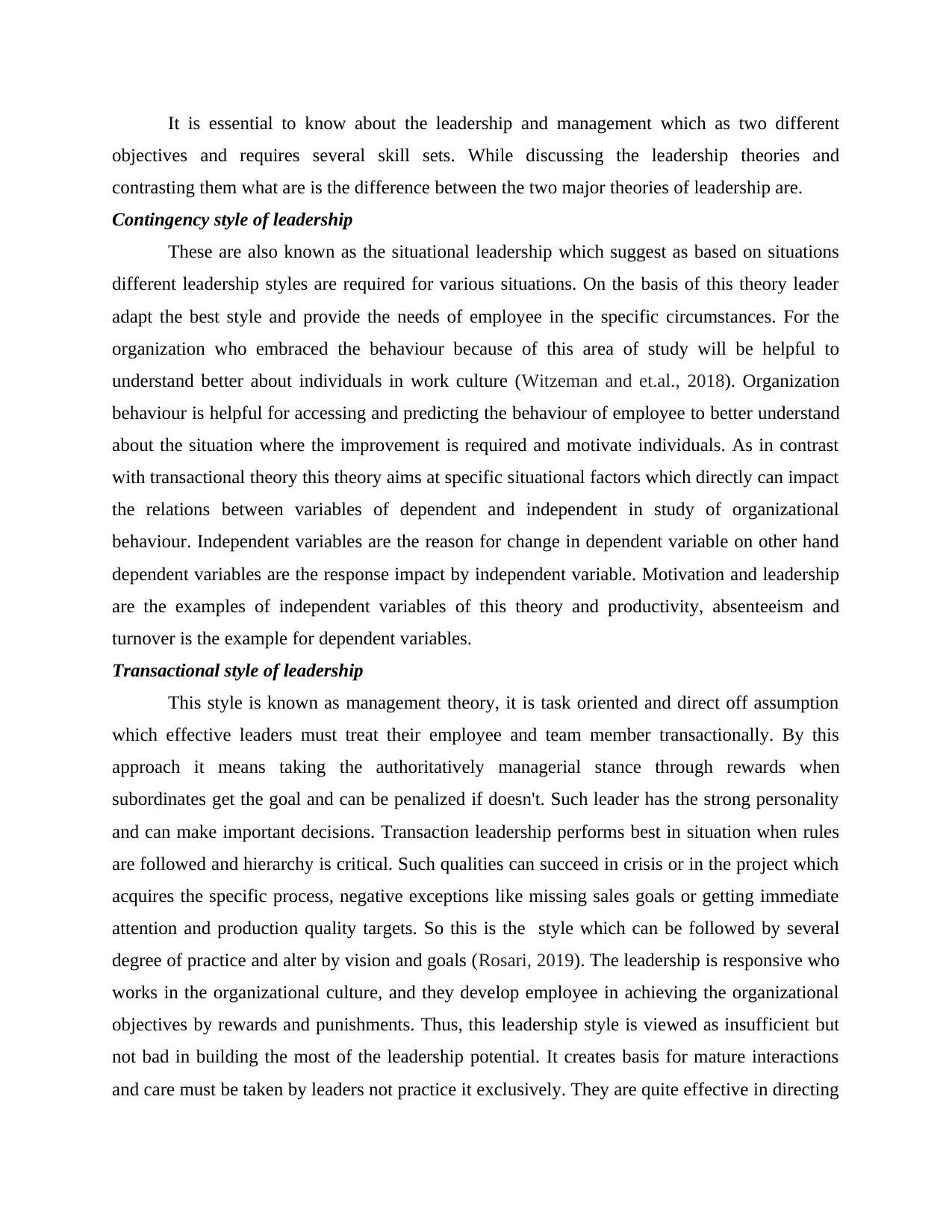
It is essential to know about the leadership and management which as two different
objectives and requires several skill sets. While discussing the leadership theories and
contrasting them what are is the difference between the two major theories of leadership are.
Contingency style of leadership
These are also known as the situational leadership which suggest as based on situations
different leadership styles are required for various situations. On the basis of this theory leader
adapt the best style and provide the needs of employee in the specific circumstances. For the
organization who embraced the behaviour because of this area of study will be helpful to
understand better about individuals in work culture (Witzeman and et.al., 2018). Organization
behaviour is helpful for accessing and predicting the behaviour of employee to better understand
about the situation where the improvement is required and motivate individuals. As in contrast
with transactional theory this theory aims at specific situational factors which directly can impact
the relations between variables of dependent and independent in study of organizational
behaviour. Independent variables are the reason for change in dependent variable on other hand
dependent variables are the response impact by independent variable. Motivation and leadership
are the examples of independent variables of this theory and productivity, absenteeism and
turnover is the example for dependent variables.
Transactional style of leadership
This style is known as management theory, it is task oriented and direct off assumption
which effective leaders must treat their employee and team member transactionally. By this
approach it means taking the authoritatively managerial stance through rewards when
subordinates get the goal and can be penalized if doesn't. Such leader has the strong personality
and can make important decisions. Transaction leadership performs best in situation when rules
are followed and hierarchy is critical. Such qualities can succeed in crisis or in the project which
acquires the specific process, negative exceptions like missing sales goals or getting immediate
attention and production quality targets. So this is the style which can be followed by several
degree of practice and alter by vision and goals (Rosari, 2019). The leadership is responsive who
works in the organizational culture, and they develop employee in achieving the organizational
objectives by rewards and punishments. Thus, this leadership style is viewed as insufficient but
not bad in building the most of the leadership potential. It creates basis for mature interactions
and care must be taken by leaders not practice it exclusively. They are quite effective in directing
objectives and requires several skill sets. While discussing the leadership theories and
contrasting them what are is the difference between the two major theories of leadership are.
Contingency style of leadership
These are also known as the situational leadership which suggest as based on situations
different leadership styles are required for various situations. On the basis of this theory leader
adapt the best style and provide the needs of employee in the specific circumstances. For the
organization who embraced the behaviour because of this area of study will be helpful to
understand better about individuals in work culture (Witzeman and et.al., 2018). Organization
behaviour is helpful for accessing and predicting the behaviour of employee to better understand
about the situation where the improvement is required and motivate individuals. As in contrast
with transactional theory this theory aims at specific situational factors which directly can impact
the relations between variables of dependent and independent in study of organizational
behaviour. Independent variables are the reason for change in dependent variable on other hand
dependent variables are the response impact by independent variable. Motivation and leadership
are the examples of independent variables of this theory and productivity, absenteeism and
turnover is the example for dependent variables.
Transactional style of leadership
This style is known as management theory, it is task oriented and direct off assumption
which effective leaders must treat their employee and team member transactionally. By this
approach it means taking the authoritatively managerial stance through rewards when
subordinates get the goal and can be penalized if doesn't. Such leader has the strong personality
and can make important decisions. Transaction leadership performs best in situation when rules
are followed and hierarchy is critical. Such qualities can succeed in crisis or in the project which
acquires the specific process, negative exceptions like missing sales goals or getting immediate
attention and production quality targets. So this is the style which can be followed by several
degree of practice and alter by vision and goals (Rosari, 2019). The leadership is responsive who
works in the organizational culture, and they develop employee in achieving the organizational
objectives by rewards and punishments. Thus, this leadership style is viewed as insufficient but
not bad in building the most of the leadership potential. It creates basis for mature interactions
and care must be taken by leaders not practice it exclusively. They are quite effective in directing
Secure Best Marks with AI Grader
Need help grading? Try our AI Grader for instant feedback on your assignments.
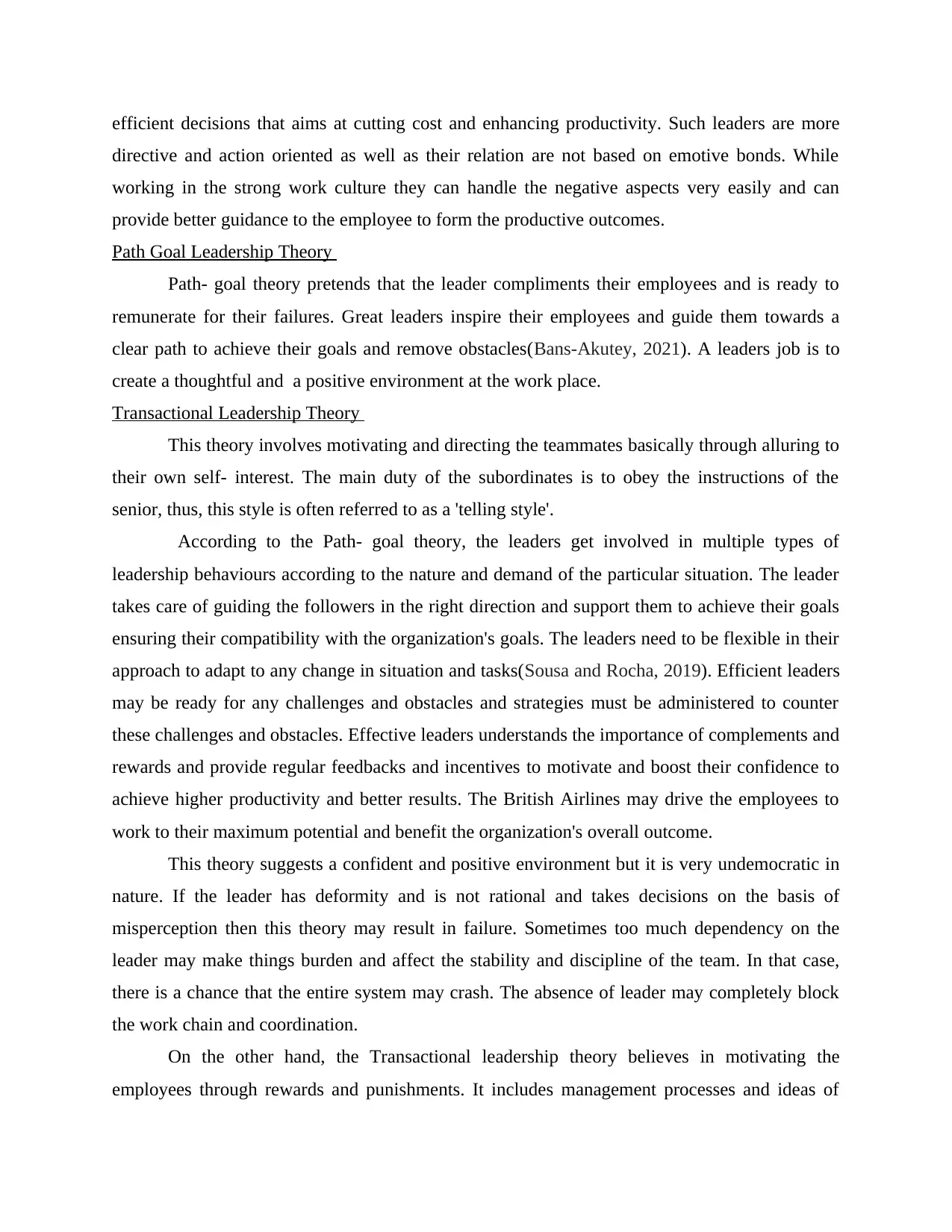
efficient decisions that aims at cutting cost and enhancing productivity. Such leaders are more
directive and action oriented as well as their relation are not based on emotive bonds. While
working in the strong work culture they can handle the negative aspects very easily and can
provide better guidance to the employee to form the productive outcomes.
Path Goal Leadership Theory
Path- goal theory pretends that the leader compliments their employees and is ready to
remunerate for their failures. Great leaders inspire their employees and guide them towards a
clear path to achieve their goals and remove obstacles(Bans-Akutey, 2021). A leaders job is to
create a thoughtful and a positive environment at the work place.
Transactional Leadership Theory
This theory involves motivating and directing the teammates basically through alluring to
their own self- interest. The main duty of the subordinates is to obey the instructions of the
senior, thus, this style is often referred to as a 'telling style'.
According to the Path- goal theory, the leaders get involved in multiple types of
leadership behaviours according to the nature and demand of the particular situation. The leader
takes care of guiding the followers in the right direction and support them to achieve their goals
ensuring their compatibility with the organization's goals. The leaders need to be flexible in their
approach to adapt to any change in situation and tasks(Sousa and Rocha, 2019). Efficient leaders
may be ready for any challenges and obstacles and strategies must be administered to counter
these challenges and obstacles. Effective leaders understands the importance of complements and
rewards and provide regular feedbacks and incentives to motivate and boost their confidence to
achieve higher productivity and better results. The British Airlines may drive the employees to
work to their maximum potential and benefit the organization's overall outcome.
This theory suggests a confident and positive environment but it is very undemocratic in
nature. If the leader has deformity and is not rational and takes decisions on the basis of
misperception then this theory may result in failure. Sometimes too much dependency on the
leader may make things burden and affect the stability and discipline of the team. In that case,
there is a chance that the entire system may crash. The absence of leader may completely block
the work chain and coordination.
On the other hand, the Transactional leadership theory believes in motivating the
employees through rewards and punishments. It includes management processes and ideas of
directive and action oriented as well as their relation are not based on emotive bonds. While
working in the strong work culture they can handle the negative aspects very easily and can
provide better guidance to the employee to form the productive outcomes.
Path Goal Leadership Theory
Path- goal theory pretends that the leader compliments their employees and is ready to
remunerate for their failures. Great leaders inspire their employees and guide them towards a
clear path to achieve their goals and remove obstacles(Bans-Akutey, 2021). A leaders job is to
create a thoughtful and a positive environment at the work place.
Transactional Leadership Theory
This theory involves motivating and directing the teammates basically through alluring to
their own self- interest. The main duty of the subordinates is to obey the instructions of the
senior, thus, this style is often referred to as a 'telling style'.
According to the Path- goal theory, the leaders get involved in multiple types of
leadership behaviours according to the nature and demand of the particular situation. The leader
takes care of guiding the followers in the right direction and support them to achieve their goals
ensuring their compatibility with the organization's goals. The leaders need to be flexible in their
approach to adapt to any change in situation and tasks(Sousa and Rocha, 2019). Efficient leaders
may be ready for any challenges and obstacles and strategies must be administered to counter
these challenges and obstacles. Effective leaders understands the importance of complements and
rewards and provide regular feedbacks and incentives to motivate and boost their confidence to
achieve higher productivity and better results. The British Airlines may drive the employees to
work to their maximum potential and benefit the organization's overall outcome.
This theory suggests a confident and positive environment but it is very undemocratic in
nature. If the leader has deformity and is not rational and takes decisions on the basis of
misperception then this theory may result in failure. Sometimes too much dependency on the
leader may make things burden and affect the stability and discipline of the team. In that case,
there is a chance that the entire system may crash. The absence of leader may completely block
the work chain and coordination.
On the other hand, the Transactional leadership theory believes in motivating the
employees through rewards and punishments. It includes management processes and ideas of
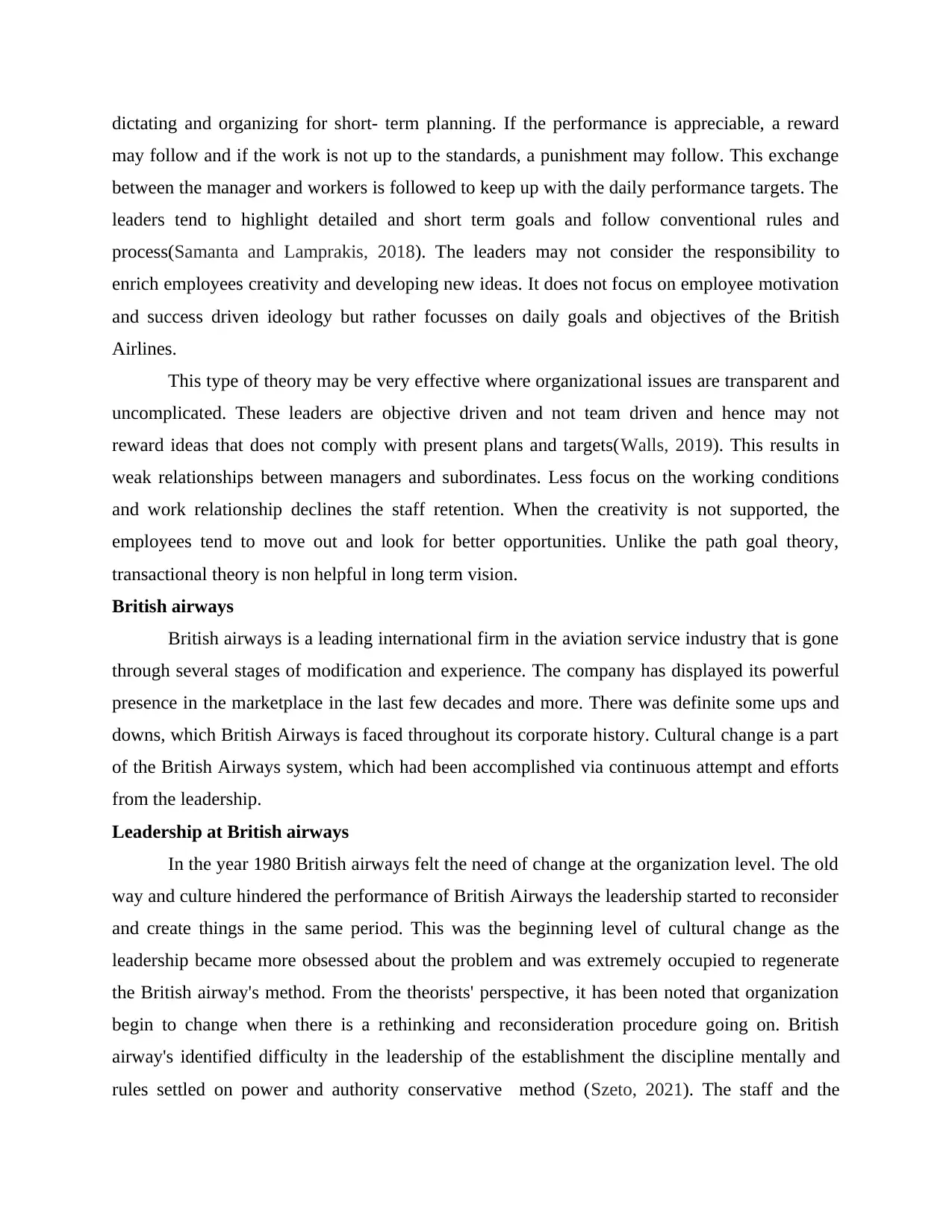
dictating and organizing for short- term planning. If the performance is appreciable, a reward
may follow and if the work is not up to the standards, a punishment may follow. This exchange
between the manager and workers is followed to keep up with the daily performance targets. The
leaders tend to highlight detailed and short term goals and follow conventional rules and
process(Samanta and Lamprakis, 2018). The leaders may not consider the responsibility to
enrich employees creativity and developing new ideas. It does not focus on employee motivation
and success driven ideology but rather focusses on daily goals and objectives of the British
Airlines.
This type of theory may be very effective where organizational issues are transparent and
uncomplicated. These leaders are objective driven and not team driven and hence may not
reward ideas that does not comply with present plans and targets(Walls, 2019). This results in
weak relationships between managers and subordinates. Less focus on the working conditions
and work relationship declines the staff retention. When the creativity is not supported, the
employees tend to move out and look for better opportunities. Unlike the path goal theory,
transactional theory is non helpful in long term vision.
British airways
British airways is a leading international firm in the aviation service industry that is gone
through several stages of modification and experience. The company has displayed its powerful
presence in the marketplace in the last few decades and more. There was definite some ups and
downs, which British Airways is faced throughout its corporate history. Cultural change is a part
of the British Airways system, which had been accomplished via continuous attempt and efforts
from the leadership.
Leadership at British airways
In the year 1980 British airways felt the need of change at the organization level. The old
way and culture hindered the performance of British Airways the leadership started to reconsider
and create things in the same period. This was the beginning level of cultural change as the
leadership became more obsessed about the problem and was extremely occupied to regenerate
the British airway's method. From the theorists' perspective, it has been noted that organization
begin to change when there is a rethinking and reconsideration procedure going on. British
airway's identified difficulty in the leadership of the establishment the discipline mentally and
rules settled on power and authority conservative method (Szeto, 2021). The staff and the
may follow and if the work is not up to the standards, a punishment may follow. This exchange
between the manager and workers is followed to keep up with the daily performance targets. The
leaders tend to highlight detailed and short term goals and follow conventional rules and
process(Samanta and Lamprakis, 2018). The leaders may not consider the responsibility to
enrich employees creativity and developing new ideas. It does not focus on employee motivation
and success driven ideology but rather focusses on daily goals and objectives of the British
Airlines.
This type of theory may be very effective where organizational issues are transparent and
uncomplicated. These leaders are objective driven and not team driven and hence may not
reward ideas that does not comply with present plans and targets(Walls, 2019). This results in
weak relationships between managers and subordinates. Less focus on the working conditions
and work relationship declines the staff retention. When the creativity is not supported, the
employees tend to move out and look for better opportunities. Unlike the path goal theory,
transactional theory is non helpful in long term vision.
British airways
British airways is a leading international firm in the aviation service industry that is gone
through several stages of modification and experience. The company has displayed its powerful
presence in the marketplace in the last few decades and more. There was definite some ups and
downs, which British Airways is faced throughout its corporate history. Cultural change is a part
of the British Airways system, which had been accomplished via continuous attempt and efforts
from the leadership.
Leadership at British airways
In the year 1980 British airways felt the need of change at the organization level. The old
way and culture hindered the performance of British Airways the leadership started to reconsider
and create things in the same period. This was the beginning level of cultural change as the
leadership became more obsessed about the problem and was extremely occupied to regenerate
the British airway's method. From the theorists' perspective, it has been noted that organization
begin to change when there is a rethinking and reconsideration procedure going on. British
airway's identified difficulty in the leadership of the establishment the discipline mentally and
rules settled on power and authority conservative method (Szeto, 2021). The staff and the
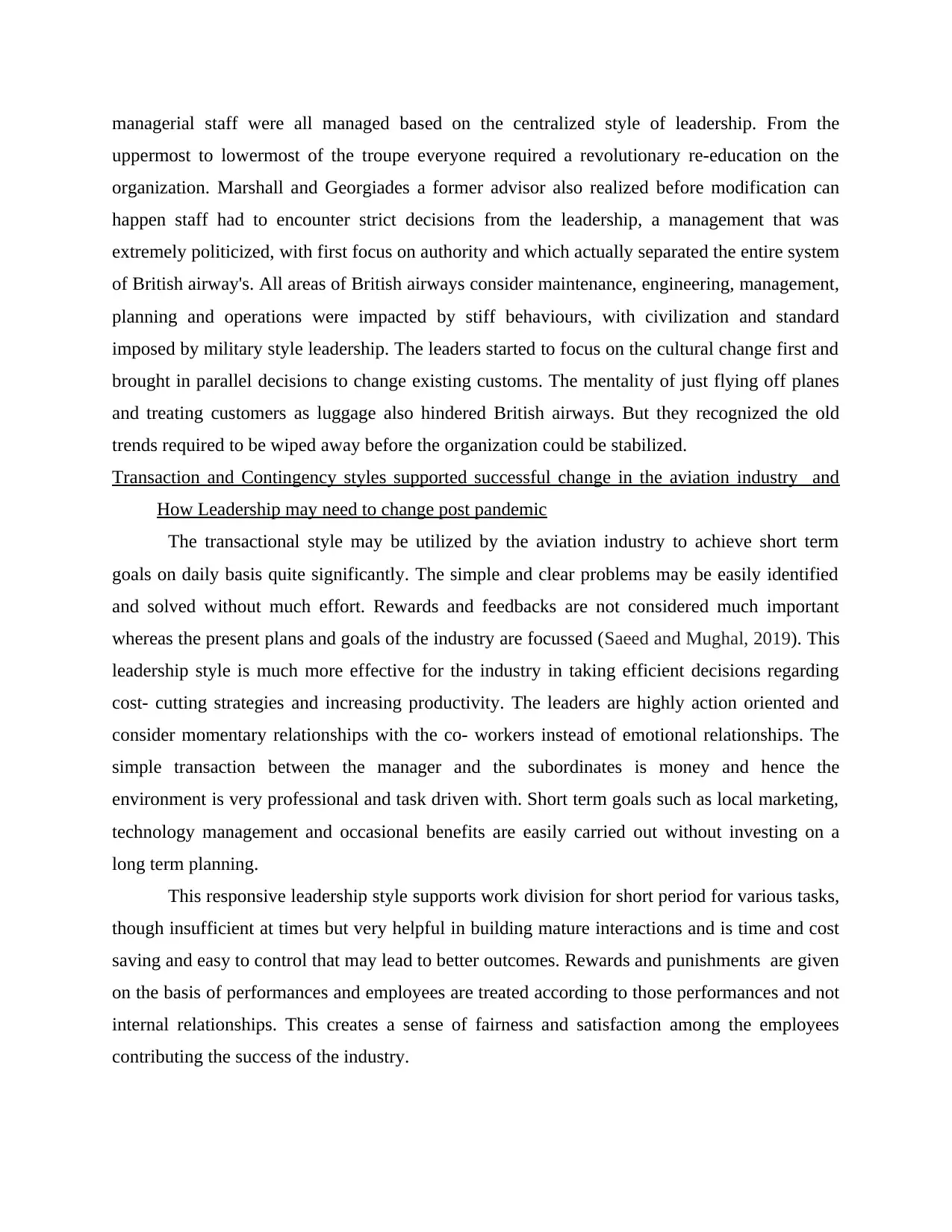
managerial staff were all managed based on the centralized style of leadership. From the
uppermost to lowermost of the troupe everyone required a revolutionary re-education on the
organization. Marshall and Georgiades a former advisor also realized before modification can
happen staff had to encounter strict decisions from the leadership, a management that was
extremely politicized, with first focus on authority and which actually separated the entire system
of British airway's. All areas of British airways consider maintenance, engineering, management,
planning and operations were impacted by stiff behaviours, with civilization and standard
imposed by military style leadership. The leaders started to focus on the cultural change first and
brought in parallel decisions to change existing customs. The mentality of just flying off planes
and treating customers as luggage also hindered British airways. But they recognized the old
trends required to be wiped away before the organization could be stabilized.
Transaction and Contingency styles supported successful change in the aviation industry and
How Leadership may need to change post pandemic
The transactional style may be utilized by the aviation industry to achieve short term
goals on daily basis quite significantly. The simple and clear problems may be easily identified
and solved without much effort. Rewards and feedbacks are not considered much important
whereas the present plans and goals of the industry are focussed (Saeed and Mughal, 2019). This
leadership style is much more effective for the industry in taking efficient decisions regarding
cost- cutting strategies and increasing productivity. The leaders are highly action oriented and
consider momentary relationships with the co- workers instead of emotional relationships. The
simple transaction between the manager and the subordinates is money and hence the
environment is very professional and task driven with. Short term goals such as local marketing,
technology management and occasional benefits are easily carried out without investing on a
long term planning.
This responsive leadership style supports work division for short period for various tasks,
though insufficient at times but very helpful in building mature interactions and is time and cost
saving and easy to control that may lead to better outcomes. Rewards and punishments are given
on the basis of performances and employees are treated according to those performances and not
internal relationships. This creates a sense of fairness and satisfaction among the employees
contributing the success of the industry.
uppermost to lowermost of the troupe everyone required a revolutionary re-education on the
organization. Marshall and Georgiades a former advisor also realized before modification can
happen staff had to encounter strict decisions from the leadership, a management that was
extremely politicized, with first focus on authority and which actually separated the entire system
of British airway's. All areas of British airways consider maintenance, engineering, management,
planning and operations were impacted by stiff behaviours, with civilization and standard
imposed by military style leadership. The leaders started to focus on the cultural change first and
brought in parallel decisions to change existing customs. The mentality of just flying off planes
and treating customers as luggage also hindered British airways. But they recognized the old
trends required to be wiped away before the organization could be stabilized.
Transaction and Contingency styles supported successful change in the aviation industry and
How Leadership may need to change post pandemic
The transactional style may be utilized by the aviation industry to achieve short term
goals on daily basis quite significantly. The simple and clear problems may be easily identified
and solved without much effort. Rewards and feedbacks are not considered much important
whereas the present plans and goals of the industry are focussed (Saeed and Mughal, 2019). This
leadership style is much more effective for the industry in taking efficient decisions regarding
cost- cutting strategies and increasing productivity. The leaders are highly action oriented and
consider momentary relationships with the co- workers instead of emotional relationships. The
simple transaction between the manager and the subordinates is money and hence the
environment is very professional and task driven with. Short term goals such as local marketing,
technology management and occasional benefits are easily carried out without investing on a
long term planning.
This responsive leadership style supports work division for short period for various tasks,
though insufficient at times but very helpful in building mature interactions and is time and cost
saving and easy to control that may lead to better outcomes. Rewards and punishments are given
on the basis of performances and employees are treated according to those performances and not
internal relationships. This creates a sense of fairness and satisfaction among the employees
contributing the success of the industry.
Paraphrase This Document
Need a fresh take? Get an instant paraphrase of this document with our AI Paraphraser
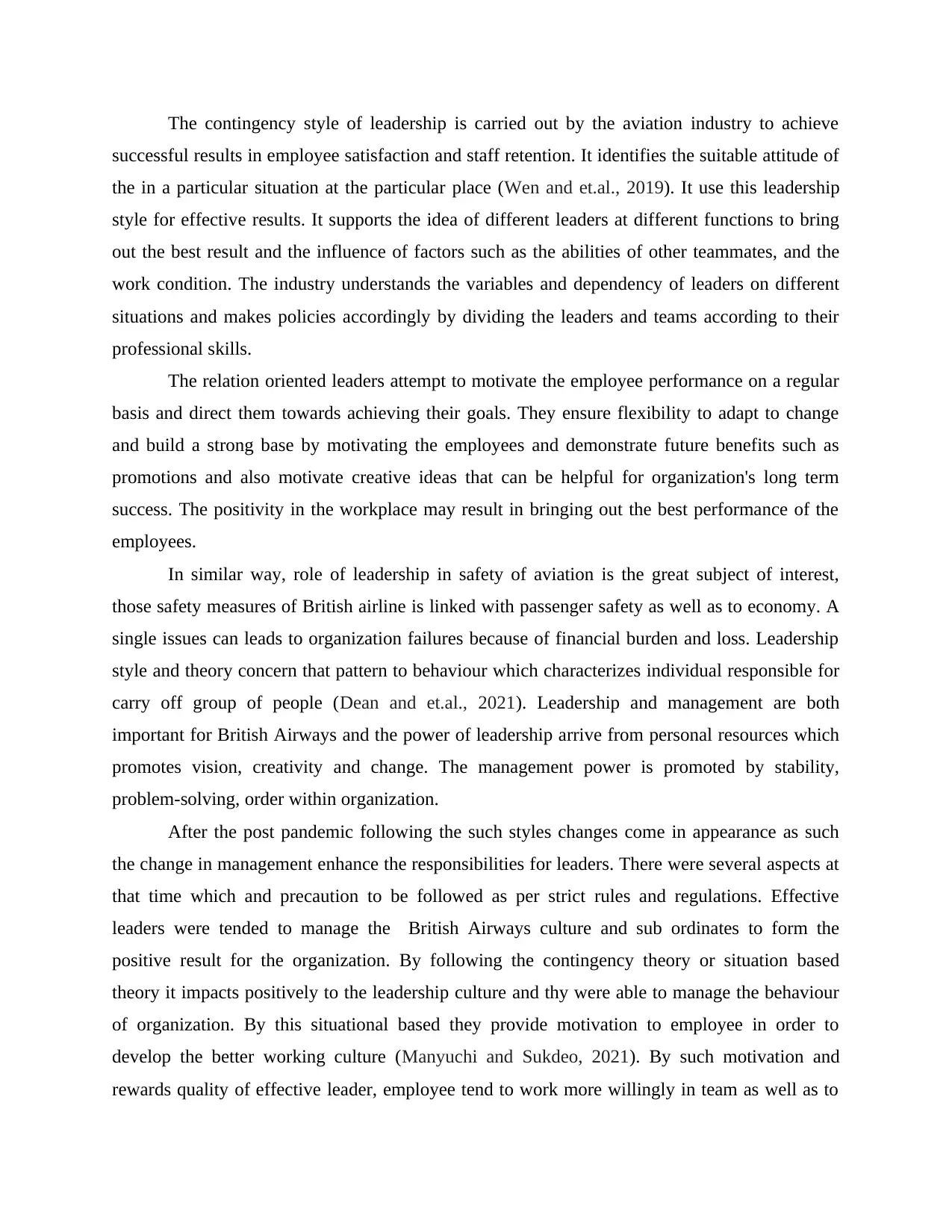
The contingency style of leadership is carried out by the aviation industry to achieve
successful results in employee satisfaction and staff retention. It identifies the suitable attitude of
the in a particular situation at the particular place (Wen and et.al., 2019). It use this leadership
style for effective results. It supports the idea of different leaders at different functions to bring
out the best result and the influence of factors such as the abilities of other teammates, and the
work condition. The industry understands the variables and dependency of leaders on different
situations and makes policies accordingly by dividing the leaders and teams according to their
professional skills.
The relation oriented leaders attempt to motivate the employee performance on a regular
basis and direct them towards achieving their goals. They ensure flexibility to adapt to change
and build a strong base by motivating the employees and demonstrate future benefits such as
promotions and also motivate creative ideas that can be helpful for organization's long term
success. The positivity in the workplace may result in bringing out the best performance of the
employees.
In similar way, role of leadership in safety of aviation is the great subject of interest,
those safety measures of British airline is linked with passenger safety as well as to economy. A
single issues can leads to organization failures because of financial burden and loss. Leadership
style and theory concern that pattern to behaviour which characterizes individual responsible for
carry off group of people (Dean and et.al., 2021). Leadership and management are both
important for British Airways and the power of leadership arrive from personal resources which
promotes vision, creativity and change. The management power is promoted by stability,
problem-solving, order within organization.
After the post pandemic following the such styles changes come in appearance as such
the change in management enhance the responsibilities for leaders. There were several aspects at
that time which and precaution to be followed as per strict rules and regulations. Effective
leaders were tended to manage the British Airways culture and sub ordinates to form the
positive result for the organization. By following the contingency theory or situation based
theory it impacts positively to the leadership culture and thy were able to manage the behaviour
of organization. By this situational based they provide motivation to employee in order to
develop the better working culture (Manyuchi and Sukdeo, 2021). By such motivation and
rewards quality of effective leader, employee tend to work more willingly in team as well as to
successful results in employee satisfaction and staff retention. It identifies the suitable attitude of
the in a particular situation at the particular place (Wen and et.al., 2019). It use this leadership
style for effective results. It supports the idea of different leaders at different functions to bring
out the best result and the influence of factors such as the abilities of other teammates, and the
work condition. The industry understands the variables and dependency of leaders on different
situations and makes policies accordingly by dividing the leaders and teams according to their
professional skills.
The relation oriented leaders attempt to motivate the employee performance on a regular
basis and direct them towards achieving their goals. They ensure flexibility to adapt to change
and build a strong base by motivating the employees and demonstrate future benefits such as
promotions and also motivate creative ideas that can be helpful for organization's long term
success. The positivity in the workplace may result in bringing out the best performance of the
employees.
In similar way, role of leadership in safety of aviation is the great subject of interest,
those safety measures of British airline is linked with passenger safety as well as to economy. A
single issues can leads to organization failures because of financial burden and loss. Leadership
style and theory concern that pattern to behaviour which characterizes individual responsible for
carry off group of people (Dean and et.al., 2021). Leadership and management are both
important for British Airways and the power of leadership arrive from personal resources which
promotes vision, creativity and change. The management power is promoted by stability,
problem-solving, order within organization.
After the post pandemic following the such styles changes come in appearance as such
the change in management enhance the responsibilities for leaders. There were several aspects at
that time which and precaution to be followed as per strict rules and regulations. Effective
leaders were tended to manage the British Airways culture and sub ordinates to form the
positive result for the organization. By following the contingency theory or situation based
theory it impacts positively to the leadership culture and thy were able to manage the behaviour
of organization. By this situational based they provide motivation to employee in order to
develop the better working culture (Manyuchi and Sukdeo, 2021). By such motivation and
rewards quality of effective leader, employee tend to work more willingly in team as well as to
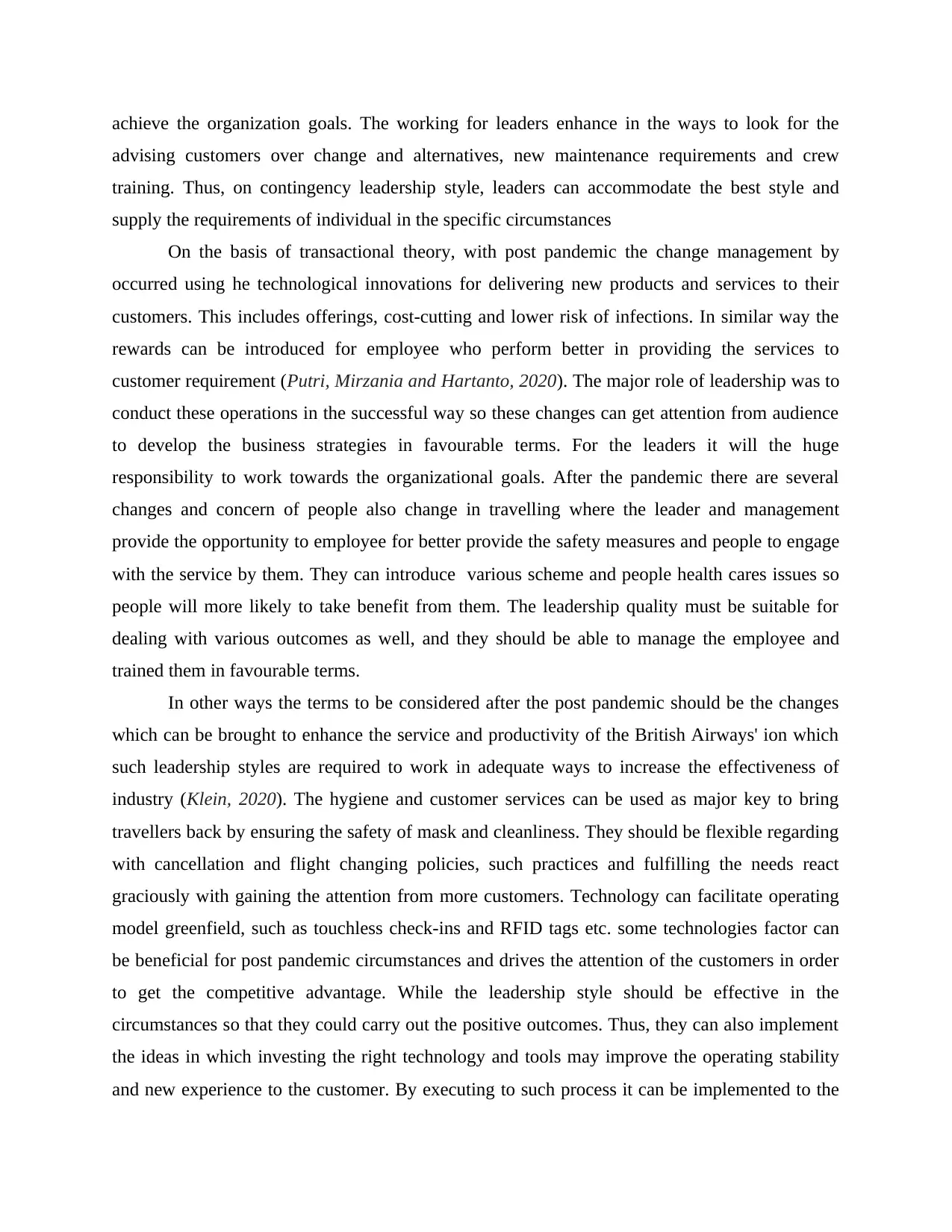
achieve the organization goals. The working for leaders enhance in the ways to look for the
advising customers over change and alternatives, new maintenance requirements and crew
training. Thus, on contingency leadership style, leaders can accommodate the best style and
supply the requirements of individual in the specific circumstances
On the basis of transactional theory, with post pandemic the change management by
occurred using he technological innovations for delivering new products and services to their
customers. This includes offerings, cost-cutting and lower risk of infections. In similar way the
rewards can be introduced for employee who perform better in providing the services to
customer requirement (Putri, Mirzania and Hartanto, 2020). The major role of leadership was to
conduct these operations in the successful way so these changes can get attention from audience
to develop the business strategies in favourable terms. For the leaders it will the huge
responsibility to work towards the organizational goals. After the pandemic there are several
changes and concern of people also change in travelling where the leader and management
provide the opportunity to employee for better provide the safety measures and people to engage
with the service by them. They can introduce various scheme and people health cares issues so
people will more likely to take benefit from them. The leadership quality must be suitable for
dealing with various outcomes as well, and they should be able to manage the employee and
trained them in favourable terms.
In other ways the terms to be considered after the post pandemic should be the changes
which can be brought to enhance the service and productivity of the British Airways' ion which
such leadership styles are required to work in adequate ways to increase the effectiveness of
industry (Klein, 2020). The hygiene and customer services can be used as major key to bring
travellers back by ensuring the safety of mask and cleanliness. They should be flexible regarding
with cancellation and flight changing policies, such practices and fulfilling the needs react
graciously with gaining the attention from more customers. Technology can facilitate operating
model greenfield, such as touchless check-ins and RFID tags etc. some technologies factor can
be beneficial for post pandemic circumstances and drives the attention of the customers in order
to get the competitive advantage. While the leadership style should be effective in the
circumstances so that they could carry out the positive outcomes. Thus, they can also implement
the ideas in which investing the right technology and tools may improve the operating stability
and new experience to the customer. By executing to such process it can be implemented to the
advising customers over change and alternatives, new maintenance requirements and crew
training. Thus, on contingency leadership style, leaders can accommodate the best style and
supply the requirements of individual in the specific circumstances
On the basis of transactional theory, with post pandemic the change management by
occurred using he technological innovations for delivering new products and services to their
customers. This includes offerings, cost-cutting and lower risk of infections. In similar way the
rewards can be introduced for employee who perform better in providing the services to
customer requirement (Putri, Mirzania and Hartanto, 2020). The major role of leadership was to
conduct these operations in the successful way so these changes can get attention from audience
to develop the business strategies in favourable terms. For the leaders it will the huge
responsibility to work towards the organizational goals. After the pandemic there are several
changes and concern of people also change in travelling where the leader and management
provide the opportunity to employee for better provide the safety measures and people to engage
with the service by them. They can introduce various scheme and people health cares issues so
people will more likely to take benefit from them. The leadership quality must be suitable for
dealing with various outcomes as well, and they should be able to manage the employee and
trained them in favourable terms.
In other ways the terms to be considered after the post pandemic should be the changes
which can be brought to enhance the service and productivity of the British Airways' ion which
such leadership styles are required to work in adequate ways to increase the effectiveness of
industry (Klein, 2020). The hygiene and customer services can be used as major key to bring
travellers back by ensuring the safety of mask and cleanliness. They should be flexible regarding
with cancellation and flight changing policies, such practices and fulfilling the needs react
graciously with gaining the attention from more customers. Technology can facilitate operating
model greenfield, such as touchless check-ins and RFID tags etc. some technologies factor can
be beneficial for post pandemic circumstances and drives the attention of the customers in order
to get the competitive advantage. While the leadership style should be effective in the
circumstances so that they could carry out the positive outcomes. Thus, they can also implement
the ideas in which investing the right technology and tools may improve the operating stability
and new experience to the customer. By executing to such process it can be implemented to the
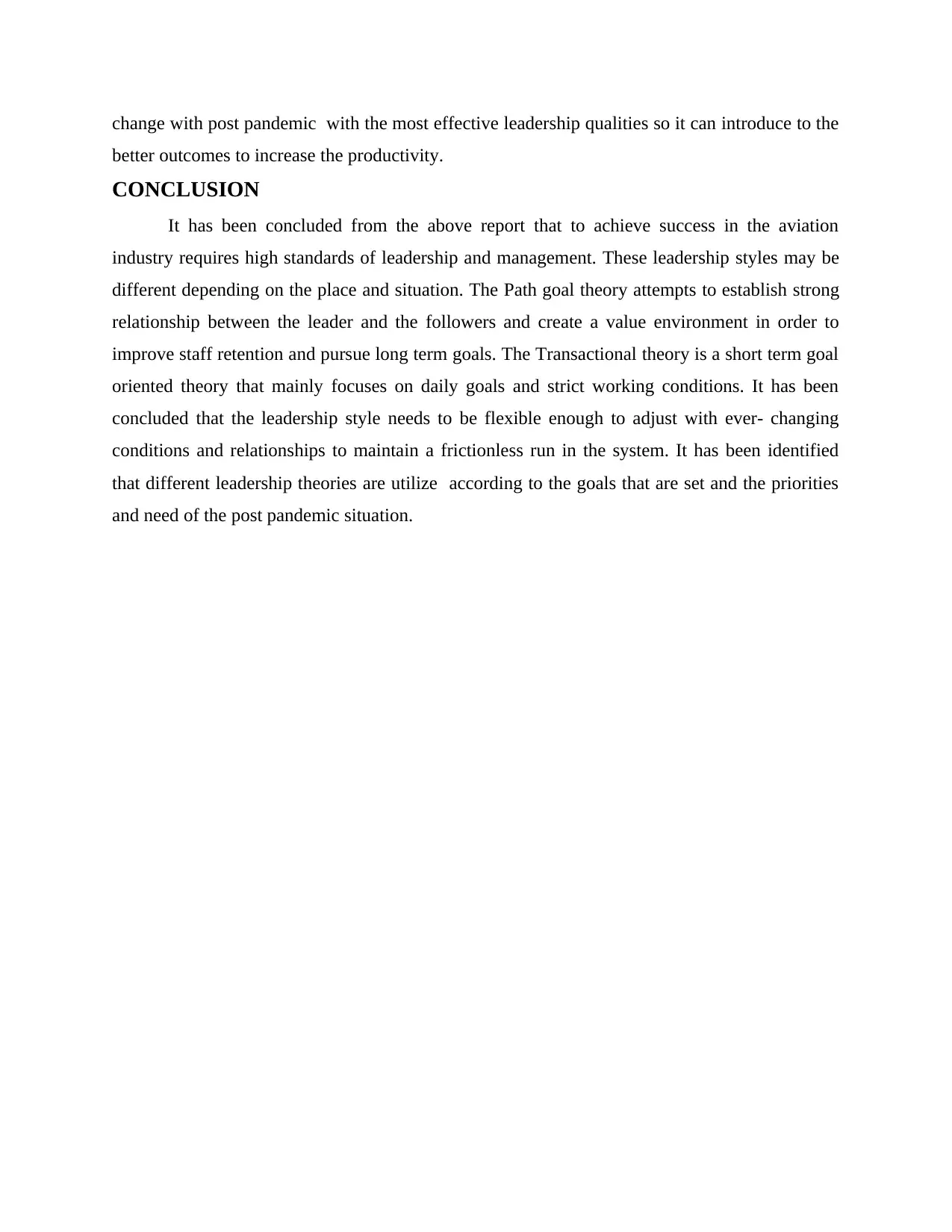
change with post pandemic with the most effective leadership qualities so it can introduce to the
better outcomes to increase the productivity.
CONCLUSION
It has been concluded from the above report that to achieve success in the aviation
industry requires high standards of leadership and management. These leadership styles may be
different depending on the place and situation. The Path goal theory attempts to establish strong
relationship between the leader and the followers and create a value environment in order to
improve staff retention and pursue long term goals. The Transactional theory is a short term goal
oriented theory that mainly focuses on daily goals and strict working conditions. It has been
concluded that the leadership style needs to be flexible enough to adjust with ever- changing
conditions and relationships to maintain a frictionless run in the system. It has been identified
that different leadership theories are utilize according to the goals that are set and the priorities
and need of the post pandemic situation.
better outcomes to increase the productivity.
CONCLUSION
It has been concluded from the above report that to achieve success in the aviation
industry requires high standards of leadership and management. These leadership styles may be
different depending on the place and situation. The Path goal theory attempts to establish strong
relationship between the leader and the followers and create a value environment in order to
improve staff retention and pursue long term goals. The Transactional theory is a short term goal
oriented theory that mainly focuses on daily goals and strict working conditions. It has been
concluded that the leadership style needs to be flexible enough to adjust with ever- changing
conditions and relationships to maintain a frictionless run in the system. It has been identified
that different leadership theories are utilize according to the goals that are set and the priorities
and need of the post pandemic situation.
Secure Best Marks with AI Grader
Need help grading? Try our AI Grader for instant feedback on your assignments.
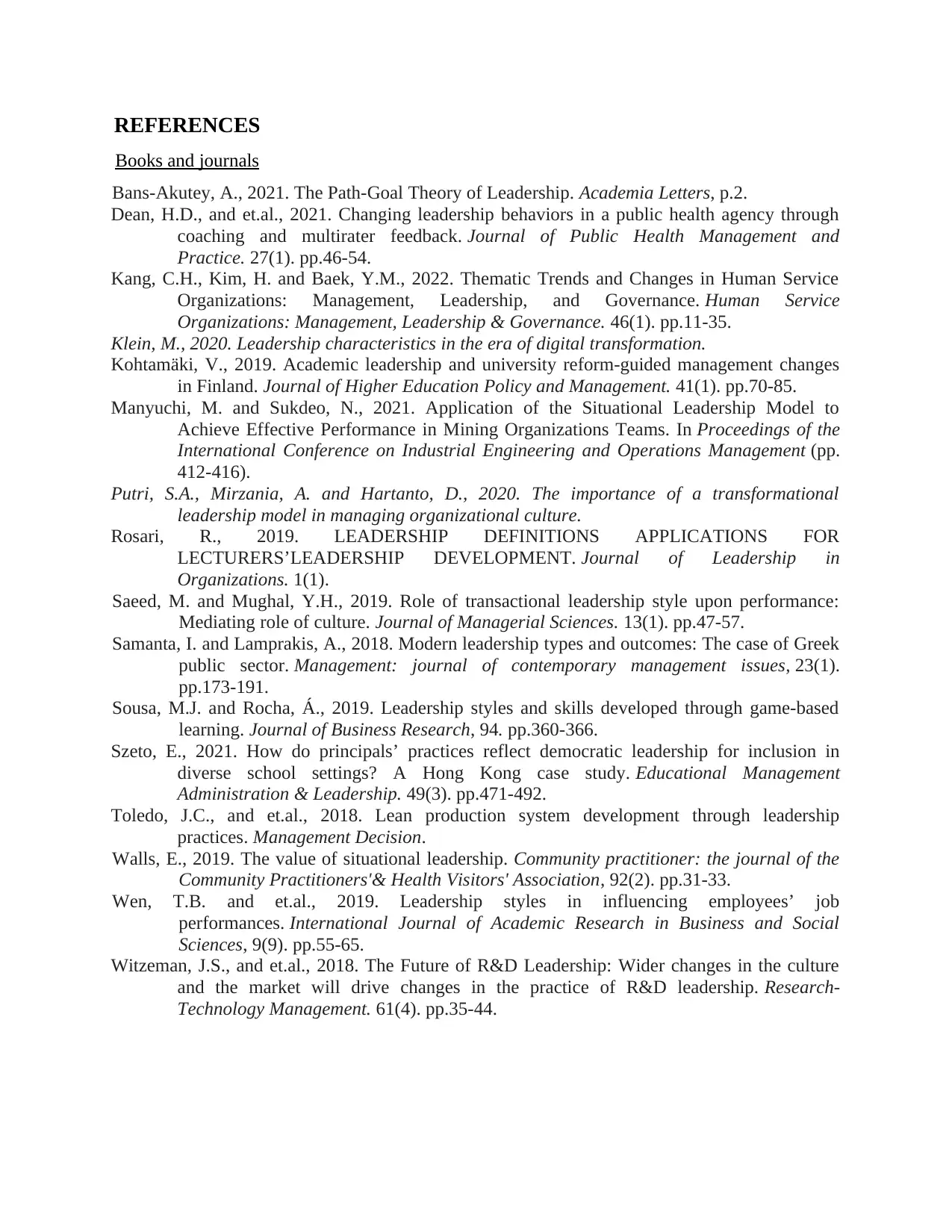
REFERENCES
Books and journals
Bans-Akutey, A., 2021. The Path-Goal Theory of Leadership. Academia Letters, p.2.
Dean, H.D., and et.al., 2021. Changing leadership behaviors in a public health agency through
coaching and multirater feedback. Journal of Public Health Management and
Practice. 27(1). pp.46-54.
Kang, C.H., Kim, H. and Baek, Y.M., 2022. Thematic Trends and Changes in Human Service
Organizations: Management, Leadership, and Governance. Human Service
Organizations: Management, Leadership & Governance. 46(1). pp.11-35.
Klein, M., 2020. Leadership characteristics in the era of digital transformation.
Kohtamäki, V., 2019. Academic leadership and university reform-guided management changes
in Finland. Journal of Higher Education Policy and Management. 41(1). pp.70-85.
Manyuchi, M. and Sukdeo, N., 2021. Application of the Situational Leadership Model to
Achieve Effective Performance in Mining Organizations Teams. In Proceedings of the
International Conference on Industrial Engineering and Operations Management (pp.
412-416).
Putri, S.A., Mirzania, A. and Hartanto, D., 2020. The importance of a transformational
leadership model in managing organizational culture.
Rosari, R., 2019. LEADERSHIP DEFINITIONS APPLICATIONS FOR
LECTURERS’LEADERSHIP DEVELOPMENT. Journal of Leadership in
Organizations. 1(1).
Saeed, M. and Mughal, Y.H., 2019. Role of transactional leadership style upon performance:
Mediating role of culture. Journal of Managerial Sciences. 13(1). pp.47-57.
Samanta, I. and Lamprakis, A., 2018. Modern leadership types and outcomes: The case of Greek
public sector. Management: journal of contemporary management issues, 23(1).
pp.173-191.
Sousa, M.J. and Rocha, Á., 2019. Leadership styles and skills developed through game-based
learning. Journal of Business Research, 94. pp.360-366.
Szeto, E., 2021. How do principals’ practices reflect democratic leadership for inclusion in
diverse school settings? A Hong Kong case study. Educational Management
Administration & Leadership. 49(3). pp.471-492.
Toledo, J.C., and et.al., 2018. Lean production system development through leadership
practices. Management Decision.
Walls, E., 2019. The value of situational leadership. Community practitioner: the journal of the
Community Practitioners'& Health Visitors' Association, 92(2). pp.31-33.
Wen, T.B. and et.al., 2019. Leadership styles in influencing employees’ job
performances. International Journal of Academic Research in Business and Social
Sciences, 9(9). pp.55-65.
Witzeman, J.S., and et.al., 2018. The Future of R&D Leadership: Wider changes in the culture
and the market will drive changes in the practice of R&D leadership. Research-
Technology Management. 61(4). pp.35-44.
Books and journals
Bans-Akutey, A., 2021. The Path-Goal Theory of Leadership. Academia Letters, p.2.
Dean, H.D., and et.al., 2021. Changing leadership behaviors in a public health agency through
coaching and multirater feedback. Journal of Public Health Management and
Practice. 27(1). pp.46-54.
Kang, C.H., Kim, H. and Baek, Y.M., 2022. Thematic Trends and Changes in Human Service
Organizations: Management, Leadership, and Governance. Human Service
Organizations: Management, Leadership & Governance. 46(1). pp.11-35.
Klein, M., 2020. Leadership characteristics in the era of digital transformation.
Kohtamäki, V., 2019. Academic leadership and university reform-guided management changes
in Finland. Journal of Higher Education Policy and Management. 41(1). pp.70-85.
Manyuchi, M. and Sukdeo, N., 2021. Application of the Situational Leadership Model to
Achieve Effective Performance in Mining Organizations Teams. In Proceedings of the
International Conference on Industrial Engineering and Operations Management (pp.
412-416).
Putri, S.A., Mirzania, A. and Hartanto, D., 2020. The importance of a transformational
leadership model in managing organizational culture.
Rosari, R., 2019. LEADERSHIP DEFINITIONS APPLICATIONS FOR
LECTURERS’LEADERSHIP DEVELOPMENT. Journal of Leadership in
Organizations. 1(1).
Saeed, M. and Mughal, Y.H., 2019. Role of transactional leadership style upon performance:
Mediating role of culture. Journal of Managerial Sciences. 13(1). pp.47-57.
Samanta, I. and Lamprakis, A., 2018. Modern leadership types and outcomes: The case of Greek
public sector. Management: journal of contemporary management issues, 23(1).
pp.173-191.
Sousa, M.J. and Rocha, Á., 2019. Leadership styles and skills developed through game-based
learning. Journal of Business Research, 94. pp.360-366.
Szeto, E., 2021. How do principals’ practices reflect democratic leadership for inclusion in
diverse school settings? A Hong Kong case study. Educational Management
Administration & Leadership. 49(3). pp.471-492.
Toledo, J.C., and et.al., 2018. Lean production system development through leadership
practices. Management Decision.
Walls, E., 2019. The value of situational leadership. Community practitioner: the journal of the
Community Practitioners'& Health Visitors' Association, 92(2). pp.31-33.
Wen, T.B. and et.al., 2019. Leadership styles in influencing employees’ job
performances. International Journal of Academic Research in Business and Social
Sciences, 9(9). pp.55-65.
Witzeman, J.S., and et.al., 2018. The Future of R&D Leadership: Wider changes in the culture
and the market will drive changes in the practice of R&D leadership. Research-
Technology Management. 61(4). pp.35-44.


13
1 out of 13
Related Documents
Your All-in-One AI-Powered Toolkit for Academic Success.
+13062052269
info@desklib.com
Available 24*7 on WhatsApp / Email
![[object Object]](/_next/static/media/star-bottom.7253800d.svg)
Unlock your academic potential
© 2024 | Zucol Services PVT LTD | All rights reserved.





